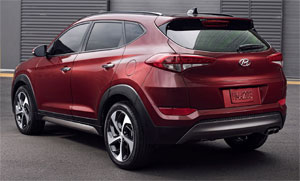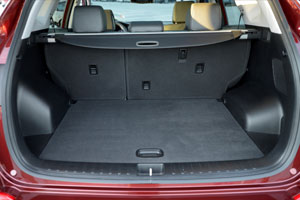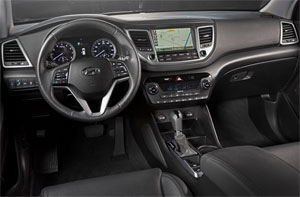2016 Hyundai Tucson
So far, Hyundai has resisted taking a plunge into the rapidly expanding pool of pint-size subcompact crossovers. But, that’s understandable as their quart-size Tucson compact ute delivers a lot more space for about the same price. Well now there’s a new Tucson, and that more for less aptitude just got even bigger.
The Hyundai Tucson has been around long enough to play a major role in Hyundai’s growth, from upstart act to Broadway box office smash.
For 2016, introducing a little more razzle-dazzle to the audience is a good play, and one consistent with most recent Hyundais. The front looks very big and bold for a compact crossover ute, and there are lots of lines flowing from there to the rear.
It very much looks like a scaled down Santa Fe, and when in Limited trim, with 19-inch wheels and LED headlights, it should help reel in those “elusive but highly sought after” younger buyers.
 Dimensions have been stretched over last year, it’s both longer and wider; and of course that translates to more room in the cabin for both people and parcels.
Dimensions have been stretched over last year, it’s both longer and wider; and of course that translates to more room in the cabin for both people and parcels.
Base engine is a 2.0-liter I4 with 164-horsepower and 151 lb-ft. of torque. Up level trims get a smaller, but stronger, 1.6-liter I4 with turbo assistance that spins up 175-horsepower and 195 lb-ft. of torque.
It also adds a 7-speed Dual Clutch Transmission, while the 2.0-liter makes do with a traditional 6-speed auto. Both engines can be had in front and lockable all-wheel drive with active cornering control.
At our test track, our turbo equipped Limited felt spirited, but far from muscular off the line; with trips to 60 taking a mundane 8.4-seconds. Torque is pretty good down low, running out of steam at the high end; but it’s certainly adequate for a compact ute. The ¼-mile pass took 16.5-seconds at 86 miles-per-hour.
 As for the DCT transmission, it proved adequate, with some occasional hesitations to get going from a stop. We also got a “high transmission temp” warning during our track day. Braking distances averaged a short 120-feet from 60; but with a long travel from the squishy pedal.
As for the DCT transmission, it proved adequate, with some occasional hesitations to get going from a stop. We also got a “high transmission temp” warning during our track day. Braking distances averaged a short 120-feet from 60; but with a long travel from the squishy pedal.
The chassis feels willing and able, with a composed non-floaty feel that’s more firm than plush. But during hard corners, the “traction control monster” awakens easily, keeping you from exploiting that feeling too much.
Taking in the scenery at a more relaxed pace, the ride is surprising enjoyable. It’s noticeably quieter and more compliant than before. The last Tucson was in a word “rough”. So Hyundai’s, increased attention to ride and handling is really paying off.
As for the ever-important drive environment inside, ergonomics are great, as is seat comfort.
The smooth looking IP is dominated by either a 5.0 or 8.0-inch center touchscreen. Hyundai’s infotainment system works well, among the best in the business, and includes a standard back-up camera.
 Despite numbers that indicate there’s a bit less legroom for rear seat passengers than before, it felt plenty roomy to us. And it enabled cargo space to go way up; now 31.0 cubic-ft. behind the standard split-folding rear seats, 61.9 cubic-ft. with them folded. That’s 20% more than the average subcompact ute.
Despite numbers that indicate there’s a bit less legroom for rear seat passengers than before, it felt plenty roomy to us. And it enabled cargo space to go way up; now 31.0 cubic-ft. behind the standard split-folding rear seats, 61.9 cubic-ft. with them folded. That’s 20% more than the average subcompact ute.
Hyundai’s hands free smart lift gate is also available.
Despite the small stature, there’s full size safety here; with an automatic emergency braking system that worked flawlessly in our barrier test. Sudden stops were abrupt enough to leave some skid marks on the pavement.
Government Fuel Economy Ratings are 24-City, 28-Highway, and 26-Combined. So our average of 26.8 miles-per-gallon of Regular was right on. The Energy Impact Score is about average for all vehicles at 12.7-barrels of oil use and 5.8 tons of CO2 emissions yearly.
And now the fine print. Base Tucson stickers for $23,595. That’s a grand more than last year. The top Tucson Limited AWD starts at $32,195.
Those higher admission prices do put a crimp in our rave review, as they are now a good deal more than a comparably equipped subcompact ute, while still less than the bestselling compacts. Still, the Tucson is fresher and better equipped. Star qualities that should impress both the critics and the masses; keeping Hyundai’s marquee shining bright.
Specifications
- Engine: 1.6 liter I4
- Horsepower: 175
- Torque: 195 lb-ft.
- 0-60 mph: 8.4 seconds
- 1/4 mile: 16.5 seconds @ 86 mph
- EPA: 24 mpg city / 28 mpg highway
- Energy Impact: 12.7 barrels of oil/yr
- CO2 Emissions: 5.8 tons/yr
2025 Volkswagen ID. Buzz
Volkswagen Brings Beetlemania Level Of Excitement To Minivan Segment
The duty of upholding Volkswagen’s heritage has most recently been delegated to small legacy car names like Golf and Jetta. But hold on! A much larger, totally modern take on VW’s classic microbus has just buzzed over the horizon— the all-electric ID. Buzz. It’s been at the top of our minds since we first saw the concept back in 2017. Well, it’s finally here, so let’s get our groove into drive!
This 2025 Volkswagen ID. Buzz has indeed created the most buzz around Volkswagen since the Beetle’s return to the U.S. in the late 1990s. We couldn’t drive it anywhere without drawing a crowd. No wonder, just about everyone has a VW Microbus story to tell, and seeing this reimagined version rolling down the street brings back all those memories.
VW really pulled it off as far as we’re concerned, as it looks great without appearing over the top. All the cues are here: Big VW logo front and center, lots of greenhouse including A-pillar windows and mini sliders for the second-row passengers, D-pillar air vents, and two-tone wheels. And while its appearance may be pure retro, its drivetrain is far from it, as the ID. Buzz is all-electric, and unlike the new Beetle, the Buzz does retain the original Microbus’ rear-drive architecture.
Powering those rear wheels is a 210-kW motor drawing juice from a 91-kWh battery for a range of 234 miles; 200-kW max charging will get you to 80% in about 26 minutes. Buyers can add another small 80-kW motor up front for 4motion all-wheel-drive and an increase of total output from 282 to 335 horsepower with a combined 512 lb-ft of torque. It uses the same battery, but range estimates drop just slightly to 231 miles. But while those numbers are modest, we also found them to be quite conservative, as we observed as many as 287 miles available in our all-wheel-drive tester’s gauge display and were on pace for 273 miles in our driving loop.
One throwback theme that may be a turnoff to some is that it’s quite a step up into the Buzz’s front seats, but there’s certainly a commanding view of the road once you climb in. Second row seating can be either a three-place bench or a pair of captain’s chairs, so there’s generous room for seven or six passengers. The captain’s chairs in our Pro S Plus offer good support and very easy access to the third row.
Lots of flexibility too with the option to simply fold the seats or remove them altogether.
With the sliding side doors and a wide opening rear hatch, there’s plenty of access for loading big sport utility amounts of cargo. Lots of flexibility too with the option to simply fold the seats or remove them altogether, and the ability to create a full-length flat floor with a rear cargo shelf that covers some handy removable storage bins. There’s 18.6 cubic-feet of space behind the third row, 75.5 behind the second, and a max of 145.5. That’s more than a Chevrolet Tahoe. For smaller items, there are lots of cubbies throughout the cabin, along with a standard Buzz Box that can be moved to multiple locations.
With a design that prioritizes retro form and modern function over aero efficiency, the 4motion equipped ID. Buzz earns a Fair efficiency rating, using 42-kWh of electricity per 100 miles, and we weren’t sure what to expect at our Mason Dixon test track.
What we found was great torque off the line and drama free launches to 60 in just 5.3 seconds. It was very stable at speed and power delivery stayed steady most of the way down the track until we reached about 90 mph, when it began to taper off just before we finished the quarter-mile in 14.0 seconds flat at 97 mph.
With 1,200-lbs. of battery weight nestled in its 127.5-inch wheelbase, the Buzz felt planted to the pavement through our handling course. There was quite a bit of body roll to deal with, but surprisingly little understeer. In panic braking runs, pedal response was inconsistent, feeling soft at times, pushing back hard at others; but through it all, results were quite good, stopping from 60 in an average of just 108 feet.
Three interior themes are available, this Dune is the brightest, featuring coastal inspired wood optic dash décor, “gray and clay” leatherette surfaces, and a high-mounted central 12.9-inch touchscreen. Pricing starts with a rear-wheel-drive Pro S at $61,545; this Pro S Plus begins at $65,045, add another $4,500 for 4motion, which brings a few extra features along with all-wheel drive.
Retro design with old-school VW charm, modern EV drivetrain, big SUV capacity merged with minivan flexibility; it all comes together in this 2025 Volkswagen ID. Buzz. It’s easily one of the coolest rides of the year and one that will likely keep Volkswagen dealers buzzing for years to come, and that’s something no other people and things mover can say.
Specifications
As Tested
- Motor Setup: Dual-Motor AWD
- Battery Size: 91-kWh
- Horsepower: 335
- Torque: 512 lb-ft
- EPA Range: 231 miles
- 0-60 mph: 5.3 seconds
- 1/4 Mile: 14.0 seconds at 97 mph
- Braking, 60-0: 108 feet
- MW Test Loop: ~ 273 miles













































